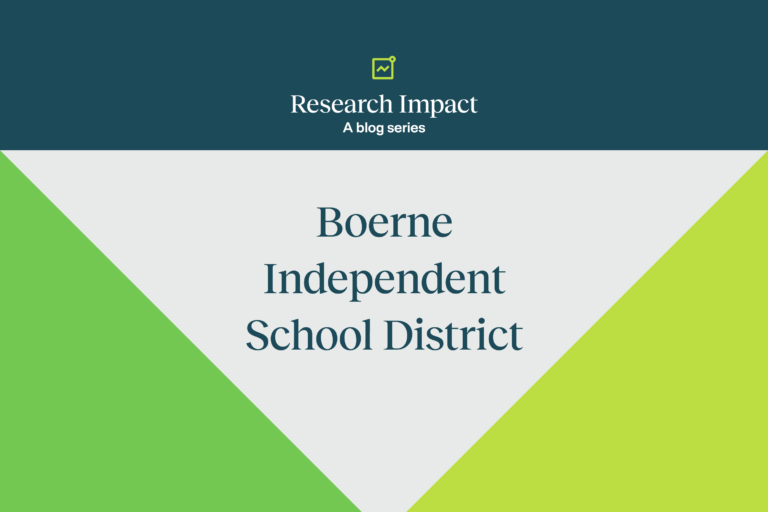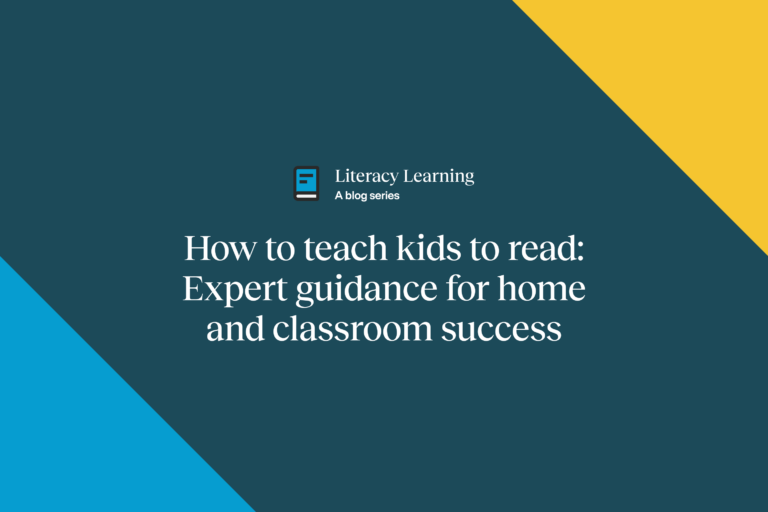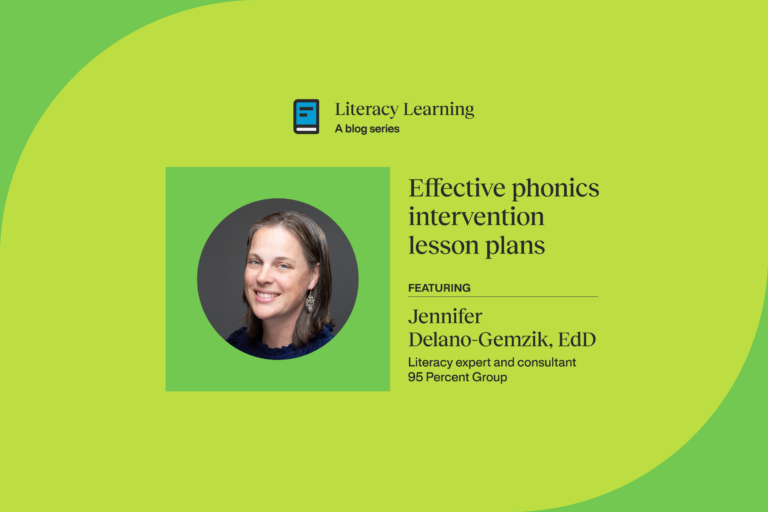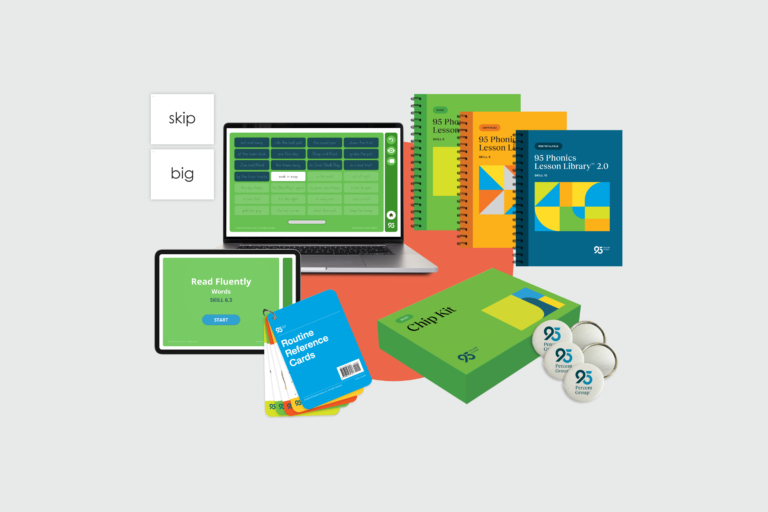What is structured literacy? An introduction for educators

With so many terms surfacing or resurfacing as we evaluate the way we teach foundational reading skills, it’s easy to be confused about how they are related or associated with one another. Laura Stewart weighs in on this in a recent article highlighting how to implement structured literacy. “Many people have asked me, ‘How do I do the science of reading?’ Here’s my answer,” Stewart said. “You can’t really DO the science of reading because the science of reading is a body of research that informs our practice. But structured literacy is an instructional approach designed to enact the science of reading research.”
Here we will dig a little deeper into what exactly structured literacy is (and isn’t!), why it’s important in today’s education climate and what’s involved in teaching strategies that support this approach.
What is structured literacy?
Grounded in the science of reading, structured literacy is an approach to teaching reading that offers students direct instruction on the specific foundational skills they need to be successful readers and critical thinkers. The teaching approach known as structured literacy takes the theories and knowledge from the body of evidence known as the science of reading and makes them actionable. This allows teachers to bring complex theories and research into their classroom in an approachable way.
Structured literacy isn’t a specific reading curriculum or professional development for teachers, but rather a framework. There are many aspects to structured literacy (see the IDA infographic here), but let’s dig into four of the principles that define the “how” of structured literacy: instruction that is explicit, systematic, cumulative, and diagnostic. Let’s look at each of these and the way they fit together.
Explicit
Learning science tells us that human brains are not naturally wired for reading. The skills necessary to decode, a fundamental skill for reading, need to be taught so that new neural pathways can be formed; for the vast majority of us, this instruction needs to be explicit. For this reason, a structured literacy approach to teaching reading requires intentional and on purpose teaching of a specific set of skills. This means teachers and students are constantly interacting, with teachers delivering highly interactive lessons using multisensorial strategies, and students receiving consistent and targeted feedback on their learning. Explicit methodology does not assume that children will absorb or figure out concepts on their own.
Systematic and Cumulative
A structured literacy approach is also based on the skills being taught in a way that is systematic and sequential. This means skills are taught in a logical way and move in order from basic to more advanced as the students progress. It’s also a cumulative approach, meaning that skills are constantly reviewed, each one reinforcing the last before moving on to something new.
Diagnostic
Instruction that is diagnostic relies greatly on individualized instruction. One thing that helps with this is frequent and consistent assessment (both observational and formal) in order to understand what each student has mastered and what they still need to work on.
These principles should guide how skills are taught. They are beneficial for all students and especially helpful for those that need extra support.
Why structured literacy?
Our go-to definition for the science of reading comes from The Reading League: “the science of reading is a vast, interdisciplinary body of scientifically-based research about reading and issues related to reading and writing…” For a more indepth look at this and how to bring the theory into action, check out our ebook, The Science of Reading 2.0: Implementation made easy).
Although it seems as if the science of reading is new and “buzz worthy,” the truth is that this body of research has been around for decades. The science of reading, however, doesn’t offer specific actionable strategies for how to teach students to read in the classroom each day.
This is where structured literacy comes in. The term structured literacy originated with the International Dyslexia Association® (IDA®) in 2016 to help educators understand and separate programs that are truly rooted in the science of reading from those that are not. A structured literacy approach is grounded in evidence-based instruction—teachers and literacy specialists use a scope and sequence which dictates the order in which concepts and content are taught using explicit and systematic, cumulative instruction.
The truth is that many teachers have graduated from teacher preparation programs without the necessary knowledge or skills to teach children how to read. Programs that are based on structured literacy can offer teachers a very specific roadmap for when and how to teach the skills that the science of reading has helped us to understand are critical to learning how to read.
Structured literacy vs balanced literacy
Balanced literacy is a concept that emerged in the 1990s after many in education were critical of and questioned the effectiveness of the whole language approach—a method that rested on several assumptions, one of which was that children could learn to read by being immersed in language and books, without a great deal of instruction. This is in direct contradiction to what the science of reading has now clearly demonstrated.
Balanced literacy, in an attempt to “balance” out the whole language approach and the phonics approach, gave little guidance on phonics instruction and instead focused on components such as reading aloud, whole class shared reading, guided reading and independent reading—without much direct instruction on skills.
Structured literacy, in comparison, relies on the sequential and cumulative instruction on a specific set of skills that lead children to a level of automatic decoding, fluent and expressive reading, and ultimately deep comprehension of text.
The building blocks of structured literacy
Literacy instruction that is based on the structured literacy approach teaches skills in a sequential and cumulative manner. As students gain more knowledge and can access advanced concepts, each of these skills within each of these components move from the most basic to more complex, continuing to build a child’s capacity to read.
Below are some of the important building blocks that make up the structured literacy approach.
Phonemic awareness
Phonemic awareness refers to a student’s understanding of, and ability to manipulate, the smallest units of sound in a word. Part of the bigger skill set of phonological sensitivity and awareness, this is where a child will first understand that sounds (phonemes) can be represented by graphemes (letters or letter patterns).
Phonics
Instruction in phonics helps students master the alphabetic principle—the idea that each sound corresponds to a letter (grapheme) or a group of letters—a critical milestone in the journey to literacy and comprehension.
Morphology

Morphology instruction serves as a bridge between phonemic awareness and the broader aspects of reading proficiency. Research says that in some cases, morphological awareness is the sole or strongest predictor for reading and spelling ability.
Deb Glaser, EdD.
Morphology instruction or morphological awareness is the understanding of the smallest units of meaning in words. According to Deb Glaser, designer of Morpheme Magic and Morphemes for Little Ones (K-3), “Morphological awareness is the understanding of the structure of words and the way in which words are formed from roots, prefixes, and suffixes. It plays a crucial role in learning to read, facilitating vocabulary development, reading comprehension, and spelling abilities.”
Syntax and semantics
Syntax refers to the structure of a sentence, including the order words appear in. Semantics, or the meaning in language, is derived from structure and word order, making syntax and semantics closely related. Instruction on syntax and semantics goes hand and hand with a skill like morphological awareness as they are both teaching students how to derive meaning from what they read and how to infuse meaning into what they write.
Reading comprehension and critical thinking
While reading comprehension is a stand alone skill and does have strategic instructional components, it also exists as the goal all students work towards as they are learning foundational reading skills. Early reading skills and ample opportunity to practice can lead students to achieve automaticity in decoding and word recognition. It is in reaching this milestone that the cognitive load is lightened and students can attend to understanding what they are reading at a much deeper level.
Comprehension skills and strategies can and should be taught, but it’s important to understand that it is both what students are working toward, and a skill that can be taught to help students gain greater proficiency and depth in understanding—particularly as they are reading more complex text.
*For the entire list of the domains of language defined by structured literacy, please refer to this infographic provided by the International Dyslexia Association (IDA).
Implementing structured literacy in the classroom
When it comes to reading instruction, I always encourage educators to follow the science of reading as well as the implementation science.
Laura Stewart
Understanding the theories and research that the science of reading offers and being able to move through a lesson with a structured literacy approach are not the same thing. Teachers need to have the knowledge and they need to have the tools to be able to implement and translate that knowledge into action for their students.
Planning and instruction
When thinking through how you want your lessons to be organized, using the “I do, We do, You do” gradual release framework is particularly helpful. As the teacher, you are responsible for the direct instruction of critical skills (the “I do” part). Then, together with your students you move through guided instruction or practice (the “We do” part), which allows your students some initial practice with new skills while you are watching carefully and can give immediate and targeted feedback if needed. Lastly, your students should have ample time and frequency of opportunity for independent practice (the “You do”). The repetition and the “on their own” practice not only helps them to become better versed in a skill, but it also helps them to build confidence in doing something unfamiliar.
Skill instruction should be sequential and predictable from the beginning in order to help the youngest students be able to trust their own knowledge of language and decoding. This sets them up to be able to engage with more complex skills as they progress.
Assessment and progress monitoring
Initial screening and diagnostic assessment with consistent progress monitoring are a hallmark of a structured literacy approach to teaching reading. Assessing students at the beginning of a school year with a universal screener gives you, the teacher, a broad baseline from which to start. Following that with a finer grained diagnostic assessment can give you information in greater detail about which skills each student has already mastered and where they still need to improve. It allows for personalized learning and scaffolding in an ongoing way that ultimately, truly, benefits every single student and ensures they get what they need for their reading success. Progress monitoring will shed light on the effectiveness of instruction and inform planning for next steps.
Engaging activities and resources
*Activities taken from 50 Nifty Activities for 5 Components and 3 Tiers of Reading Instruction
Walkabout Sound Matching
Component: Phonemic Awareness
This is a game that helps students understand and match initial sounds in words. It gives students an opportunity to compare and contrast sounds in order to make judgments about them. This activity also helps to strengthen sound/symbol connection which is critical for developing automaticity with the alphabetic code.
What you’ll need:
- Picture cards or objects
- Student whiteboards, dry-erase markers, and erasers
What you’ll do:
Set the purpose: Say: “You are going to practice listening for and matching the sounds in the names of different pictures and objects. Being able to hear sounds and discover sounds that match will help you to become good readers.”
- Distribute one picture card or object to each student. These will be used for matching initial sounds.
- Hold up a picture or an object (such as a pot) and say the name of the object, “pot,” and the initial sound in the word, “/p/.”
- Hold up other pictures or objects and have students name the initial sound in each.
- Ask students, one at a time, to stand up with their picture and say the initial sound of the object shown. Have students remain standing.
- Next, have one student walk around the room, holding his picture in front of him so that everyone can see it and can think about the beginning sound. When the student circling the room finds someone whose picture has an initial sound that matches his, he stands alongside that student. (The student who has the pie may stand next to the student who has the pin.)
- Repeat this process two times, then ask students to walk around the room and find a picture that has a beginning sound that matches their own.
- If time permits, collect the pictures, redistribute them, and repeat the activity.
Return to the purpose. Say: “Listening for sounds and discovering matching sounds will help you become good readers.”
Walkabout Words
Component: Phonics and morphology
Walkabout Words is an activity that reinforces phonics and morphological concepts that have been previously learned. It allows students to think about and analyze phonics concepts as they move about the room, looking for other students who hold word parts with which they can build a multisyllabic word that you provide from content-area selections.
What you’ll need:
- Index cards with word parts written on them
- Student whiteboards, colored dry-erase markers and erasers
- Sticky notes and file folders
- Picture cards (optional)
What you’ll do:
Set the purpose. Say: “This activity will give you practice building words using word parts you already know. Understanding and recognizing word parts will help you to read big words more easily.”
Choose word parts, based on previously learned phonics or morphological concepts, and write them on index cards. Use content area multisyllabic words or words from grade-level stories or passages. For example, if the class has been learning about desert habitats, you might use the following word parts: /liz/ /ard/ /rep/ /tile/ /des/ /ert/ /cac/ /tus/
- Distribute the cards to the whole class (or to part of the class).
- Have all students with word part cards walk around the room, holding their card in front of
them so others can see it. - Tell students to look for a word part that will help them complete a whole multisyllabic word. When they find a match that makes a complete word, they should stop and stand with the person holding the matching card and become partners.
- After everyone is matched, have the student pairs take turns reading their words so the whole class gets the benefit of hearing all the words.
- Record the words on the board so the entire class can benefit from everyone’s efforts (and to use later during independent practice).
- On the walls around the room, tape pieces of cardstock with one syllable type listed on each (open, closed, silent e, r-controlled, consonant + le, vowel pair). Ask students to move to the sign that represents their syllable. If you have taught only two or three types of syllables, then only sort for those syllable types.
Flyswatter Morphemes
Component: Vocabulary
Reading big words demands advanced decoding skills. Because English is a morpho-phonological language, students are better equipped to read big words when they have had systematic instruction in both the syllable types and morphemes of the language. Flyswatter Morphemes is an activity that emphasizes the development of speed and accuracy with morpheme recognition in words and in isolation. Moving students from knowing the morphemes to recognizing them quickly and automatically can increase their ability to read big words fluently, and reveal the meanings of new words.
What you’ll need:
- List of morphemes
- Chart paper and tape
- Flyswatters
- Index cards with morphemes on them; index cards with multisyllabic words on them containing the same morphemes
- Pictures (optional)
What you’ll do:
Set the purpose. Say: “This activity will give you practice recognizing morphemes quickly and accurately. Becoming automatic with your ability to recognize morphemes will help you to read and understand big words more easily.”
- Divide the class into two teams and have the teams line up on both sides of the room.
- Put a list of morphemes that have been previously taught on the chart pad. It might
look something like the following: mis- re- dis- un- pre- sub- anti- non- uni- trans- bi- tri- - Call on one student from each team to approach the front of the room and give both students a flyswatter.
- Say, for example: “Find the prefix that means ‘do again.’”
- The first student to swat the prefix re- with the flyswatter scores one point for his team.
- If he can then read the syllable correctly, he will get an extra point for his team.
- The two students pass their flyswatters to the next students in line and then walk to the end of the line.
- Repeat this activity for a specified time. At the end of that time, the team with the most points wins. The pacing should be fast and fun. The goal is to get to automatic recognition.
- When students are ready, repeat this activity with multisyllabic words.
Return to the purpose. Say: “You have been practicing recognizing morphemes. Becoming automatic in recognizing morphemes will help you read and understand big words more easily.”
The impact of structured literacy
The impact a structured literacy approach to teaching reading can have on both teachers and students cannot be overstated. By engaging in ongoing professional learning and coaching that helps teachers to feel confident in their instruction, they are learning components of language and literacy that they often didn’t learn in their teacher preparation programs.
By offering all children this type of sequential, cumulative, diagnostic instruction that’s based in science, we are finally giving all children the chance to lead a more enjoyable, more socially, academically, and economically successful life than ever before. Giving children the keys to reading and writing means unlocking their true learning potential.
Looking for specific stories and the data to support the success? Check out our success stories on the blog and browse our many resources that highlight the efficacy and effectiveness of structured literacy and 95 Percent Group’s approach to unlocking literacy and empowering all children.
Conclusion
The science of reading offers us the “what”—decades of research saying: there is a right way to teach children how to read. Structured literacy now offers us “the how:” specific guidelines by which to build your literacy instruction framework and tool box in order to best prepare ALL children for successful reading and writing.
For more information on structured literacy and the turnkey resources available to make your classroom instruction and intervention aligned with what all of your students need, check out 95 Percent Group’s One 95 Literacy Ecosystem™ for all of your Tier 1, Tier 2 and Tier 3 needs today.
Resources
- International Dyslexia Association. (2018, March 27). Effective Reading Instruction – International Dyslexia Association. https://dyslexiaida.org/effective-reading-instruction/
- https://app.box.com/s/mvuvhel6qaj8tghvu1nl75i0ndnlp0yz
- https://www.fldoe.org/core/fileparse.php/16294/urlt/morphemeML.pdf



